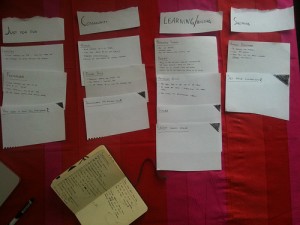By Mary Sutton / mary_sutton73
 When a group of writers get together, one of the ways to start an energetic debate is to ask a simple question.
When a group of writers get together, one of the ways to start an energetic debate is to ask a simple question.
Are you a plotter or a pantser?
If you don’t know, the question really goes to the heart of how you plan out a story. A “plotter” has an outline, sometimes written in incredible detail. She knows exactly where her story starts, ends, and every twist in the middle. There’s room for surprise and change (hopefully, because, as the saying goes “no plan survives first contact with the enemy), but this writer knows each day, scene by scene, exactly what must be written.
By contrast, the pantser runs free and wild through the great expanses of imagination. She may sit down every day not knowing exactly what she’ll be writing. Her heart will let her know. Who done it? Who knows! Not me – yet. I have a friend who said she writes every day to find out what happens. And yet, by the end of the story, you’d never know it. Now that’s skill.
I’ve toyed with both ways. More and more, I think I fall somewhere in the middle – and it very much depends what I’m writing as to whether I’m more on one side of the fence or the other.
When I write my Hero’s Sword stories, I have a general narrative outline. It keeps me from wandering too far afield – although on at least one occasion, I didn’t consult the narrative quite as often as I thought, so I diverged wildly. But that’s okay, because I liked the new approach better.
Short stories? I might have a general story question and some idea of the “bad guy,” but that’s about it.
Now, when I sat down to write the first draft of Every Other Monday is Murder, the first novel in my Laurel Highlands Mysteries series, I planned. I had a ten-page narrative. From that narrative, I generated a list of scenes, which I dutifully wrote in exactly the order I’d mapped out.
The good news is, by the end of the first draft I had a structurally solid story that hit all of the right points at the right times, that met my target word count (actually, I was about 15,000 words under).
The bad news? It totally lacked soul.
Now don’t get me wrong. There were good parts and as I re-read my draft, after an appropriate time for “marinating,” there were scenes and sections that definitely made me smile. And there were some that just, well, let’s just say I marked for some heavy rewrites. But perhaps the most telling thing, for me, was the story plodded. Yes, it hit all of the right marks and technical details. But it was the difference between memorizing Beethoven’s Moonlight Sonata, and interpreting it. All the notes are the same, but the feeling is totally different.
To be fair, this is expected. It was, after all, a first draft. There were going to be holes, things that got tossed aside, and things that were kept. But I’ve discovered something through this first round of revision. The narrative and the scene list have been tossed aside. Yes, I’m not sure all these scenes make sense in these exact places. I’m sure they’ll be moved at least twice more, and I am now 10,000 words over my target (and adding more every day). But the story has taken on life, and soul. It’s starting to sing. And that’s important too.
Recently, I toyed with the idea of submitting a short story. But I really didn’t have an idea. Then I thought “what if”? And I just started typing. I had no idea where I was going. I was writing to find out. In the end, I had a story, well under the target limit, that I actually liked. And after a few rounds of polishing, and some early-reader feedback, I sent it out. It was exciting and exhilarating. I felt so daring.
It was also a 2,500 word short story. Could I do that for a 90,000 word novel? I don’t know. Maybe I’d end up with a mess. Strike that, I do know – I would end up with a mess because that’s how I wrote the very first novel I ever attempted.
But this has taught me something about myself as a writer – something I think is valuable to know. The plot, the structure, is important in that first draft to make sure the “frame” of the house I’m building won’t collapse under the weight of all those fancy decorations and woodwork. But to get at the heart of the fancy decorations, to really make the story sing to me, I have to throw away the structure that helped me through that first draft.
So, hybrid plotting/pantsing. Perhaps that makes me a “plantser”?
Image courtesy of Linus Bohman, used under Creative Commons license

I think of myself as a mapper. I know where I’m going and I have a fair idea of the route but I never miss a chance for a detour or a side trip if the spirit moves me. Some of these stay in, some get cut – but even the cuts usually yield something worth working in somewhere else.
That is an excellent term. After finishing my latest revision, I am inclined to say I’m in the same category. Yeah, I know where I want to end up, but someones the side trips are where all the fun is.